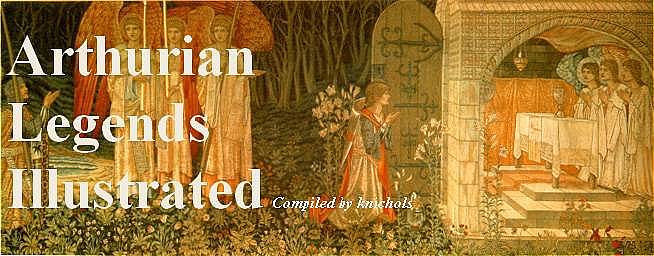
Best Viewed: Internet Explorer

![]()
The quest motif in Arthurian literature is traditionally a male paradigm, but some contemporary women writers and artists have been creating a counter tradition of "revisionist mythmaking"--a re-writing or re-visioning of the quest that foregrounds the female implications of traditional quest/grail imagery and addresses specifically the relations among women, nature, and the creative imagination. Scholar Estella Lauter claims that the fantasy and female-centered art of Remedios Varo reveals the same stages found in traditional quests: the Separation, the Initiation, and the Return. See what you think as you view the following images accompanied by selected quotations from Lauter's Women as Mythmakers: Poetry and Visual Art by Twentieth-Century Women (Indiana UP 1984).
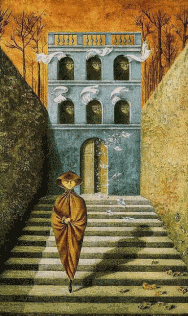
[Page 89] "One of Varo's first paintings . . . shows a cloaked and hooded female descending a walled flight of steps from an imposing building, under the ominous gaze of six human figures. She walks straight toward us with . . . her hands folded in resolution. . . . Her garment suggests that she is leaving a convent; its folds, however, suggest the vaginal shape that surrounds several questers in Varo's later work."
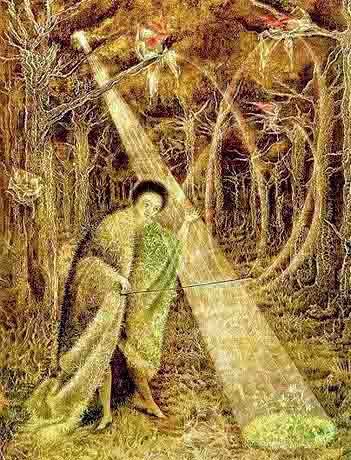
[Page 81] "[In Solar Music] . . . a woman plays a stringed sunbeam with her bow, and the music releases the birds in nearby trees from their cocoon-like capsules. Where illumination from the sun falls, it makes both the forest floor and her mantle green; but [Page 83] it is her own music, rising in arcs from the point where her bow touches the strings, that releases the birds from their torpor. . . ."
[Page 83] "The creator in Solar Music has the power to affect her environment not by accident or by fate but because she is attuned to the sunlight."
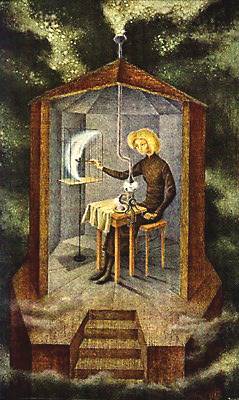
[Page 90] "[This painting creates] an image of female nurturing . . . . The protagonist is seated at a table inside an octagonal enclosure in the sky. She is grinding the food from the stars and feeding it to the moon in its cage. She is at once powerful and impotent. Because the moon is waning, it seems likely that she is saving it from death. . . . A closer look at her setting reveals the source of her ambivalence; although there are steps leading from her enclosure, she could not take them unless she could walk on clouds. . . . [She] is as caged as the moon. . . ."
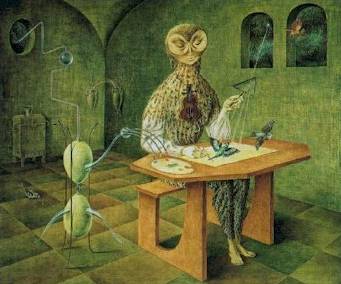
[Page 84-5] ". . . [T]he protagonist has assumed the form of an owl in order to paint birds who will come to life and take flight for the first time. . . . She dips the brush, attached to her own violin (in the place of her heart), into paint from an alchemical alembic where the substance from the stars is stored. With her other hand, she holds a triangular magnifying glass to intensify the light from the moon. . . . The woman/owl gives wings to her visions of the birds."
[Page 91] ". . . [This] is her image of what will be required if human creators wish to make a world in which all the species of life can survive. Her choice of the owl, always a figure of wisdom, is clarified by the information that the pre-Hellenic, Cretan Athena was a patron of the arts and a goddess of renewal . . . ."
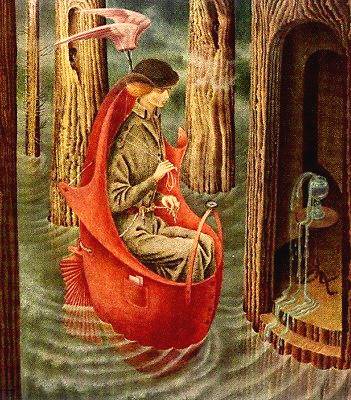
[Page 92] "In the midst of all these images of the transformed or the stymied quester is Varo's most explicit image of a journey. In Journey to the Sources of the Orinoco River, an amazon dressed in army fatigues and a bowler hat nagivates a womb-like egg-shaped vessel . . . riveted together and equipped with modern instruments for navigation. The journey has ended in a primeval forest which has drowned in the water that spouts from a goblet-fountain on a table in a hollow tree-trunk. . . . This may have been a sacred place of origins, but now it is nothing more than another landmark of civilization."
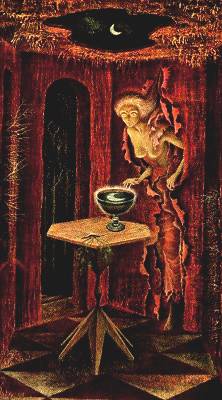
[Page 92] "The moment of discovery in Varo's rendition of the quest occurs in Born Again. It is the discovery of the grail, which eluded all but three of King Arthur's knights. The naked female breaks through a wall into a sacred space that contains the grail, miraculously full and containing the reflected image of the crescent moon. . . . It is an ecstatic moment, . . . entirely feminine because of the ancient association of the woman with the vessel and the moon, and because of the vaginal imagery presented in the tearing wall. . . . [T]he protagonist has become her own fate."
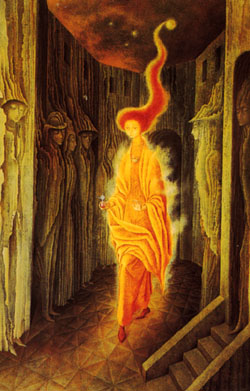
[Page 92] ". . . [T]he quester is dressed in an incandescent flame-like garment. Her[Page 94] red hair reaches up to and wraps around the largest celestial body in the dark sky. She moves forward swiftly, carrying a vial of precious fluid and wearing an alchemist's mortar around her neck. The citizens, so immobile that they have become part of the city walls, indicate no awareness of her presence. No one acknowledges her triumph, her apotheosis as a goddess of fire or as a spiritual alchemist who has produced the elixir of life."
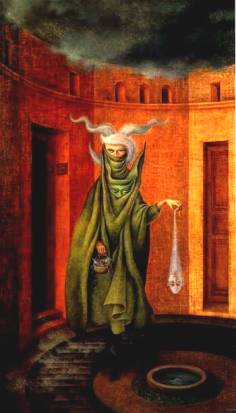
[Page 94] ". . . [T]he woman, wearing a green cloak, holds her father's head by the beard and prepares to drop it into the well. . . . Her vision has enabled her to discard her father's head (the most powerful embodiment of all that is threatening to her) along with other elements (a clock, a key, a pacifier) that Varo labels 'psychological waste.' Part of her mask has slipped in the process, but her mouth is still covered."
[Page 96] "Far from achieving atonement with the father, she must dispose of his head and assume the ultimate task of creation, the resurrection of nature, by herself. . . ."
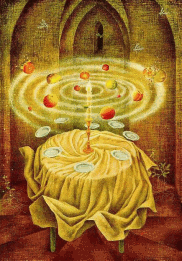
[Page 86] "[This painting] shows plates of fruit being set in motion by a candle in the center of a table, and spiralling upward and outward until the fruit smashes to release its seeds, which become plants and flower immediately . . . . Varo's creator must now resurrect vegetable life. . . . Perhaps this is the most radical image of human creativity we can imagine--this god-like responsibility for the continuation of inanimate life."
![]()
Links
Varo's artwork: 9 pictures; 12 pictures--click on "exhibit"; 11 images.
Commentary on Varo's work and short biography: retrospective.
Scholarly article on Thomas Pynchon's use of Varo.
Large images of Varo paintings referred to in Pynchon's Lot 49.
![]()

NOTE: Students should be advised that there is no one standard version of the King Arthur legends. This "Arthurian Legends Illustrated" represents an amalgam of different artists' views.
Painting, top of page: "Attainment of the Holy Grail" (tapestry) by E. C. Burne-Jones
File last updated: 1/04/12
Comments/suggestions: knichols11@cox.net